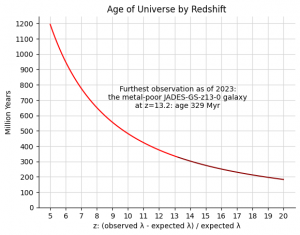Cosmological Nostalgia Content

Later renouncing clickbait, Einstein called his inclusion of cosmological content in general relativity the biggest blunder of his career.

Later renouncing clickbait, Einstein called his inclusion of cosmological content in general relativity the biggest blunder of his career.
The title of this comic is a combination of "cosmological constant" (an astrophysics term related to dark energy and to the accelerated expansion of the universe) and "nostalgia content" (clickbait marketing aimed at a specific age group referencing pop culture from their youth). The canonical examples of nostalgia content are "Only 90s Kids Remember..." and "Feel Old yet?", and this has also formed the basis for several XKCD comics. Some people of relatively advanced years like to make comparisons to others in their age group of where events that they remember fit into history; e.g., "The first moon landing was closer to the end of World War I than to today."
 Redshift indicates the age of the universe for distant astronomical objects as we observe them today, when the universe is 13.78 billion years old.
Redshift indicates the age of the universe for distant astronomical objects as we observe them today, when the universe is 13.78 billion years old.In cosmology, z is the symbol for redshift, the effect whereby photons traveling from an object that is moving away from the observer exhibit an increase in wavelength, resulting in their color shifting towards the red end of the spectrum, and the variable z quantifies this amount of shift. Due to the expansion of the universe, objects that are further away from us appear to be moving away from us at a faster velocity, resulting in higher redshift. As light has finite velocity, it takes a longer time for light from faraway objects to arrive at the observer. So the light observed at the present must have been emitted by the faraway object further back in time. In this sense, after assuming a cosmological model, redshift and cosmic time can be put in a one-to-one relation and are often used interchangeably by astronomers. Redshift z = 10 would correspond to about 500 million years after the universe was formed, or almost 13 billion years ago[1]. Megan is stating that only people that were born at that time (z = 10) can remember when the first stars were still forming. At redshift z = 10 the matter filling the universe was mostly constituted of neutral hydrogen gas, referred by Megan as "cold" (it had a temperature of about 300 K) and "dark" (there were no light sources in the universe before the first stars formed. This epoch is indeed called the cosmic dark ages). The ultraviolet light emitted by the first stars started ionizing the hydrogen around them in expanding hot plasma bubbles. This process (called reionization) had probably already begun at z = 10, but was really completed only at about z = 6, when the intergalactic hydrogen was completely ionized, as it continues to be at the present day.
Megan also has a red tint (she is drawn in the color #462424, a very dark red; here is a comparison of #462424 and black: ), indicating that she is one such z = 10 kid, because her image is red-shifted, in the literal sense. The irony is that even if she were actually born 13 billion years ago (which would be absurd,[citation needed]) her image would not appear red-shifted to us now. She would only appear redshifted to a far away observer looking at the young Megan wandering about the primordal cold dark gas.
White Hat, meanwhile, is referencing the fact that the universe has three eras: radiation dominated, matter dominated and dark energy dominated. As the universe expands, the density of radiation and matter decreases due to their dilution, causing the universe, which first started off being dominated by radiation, to then become dominated by matter, then by dark energy (which is thought to not dilute as the universe expands). The dark energy dominated era, which is when "dark energy started accelerating the universe's expansion" started around 5 billion years ago, whilst bacteria evolved around 3 billion years ago, meaning that they evolved closer to dark energy domination than to today.
The title and title text play with the similarity in sound between 'content' and 'constant', segueing between web(page) content and cosmological constant.
The title text refers to Einstein's inclusion of the cosmological constant to his theory of general relativity in order to attain a static model of the universe, which he later removed, reportedly referring to it as his "biggest blunder". Cosmological constant has, today, been generally accepted as a part of the current cosmological model, relating to the concept of dark energy. It is a pun on content and constant. The title text makes the claim that Einstein actually had cosmological content, which he used to clickbait, and he removed it to renounce clickbait.